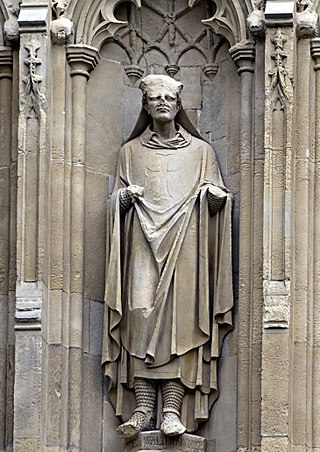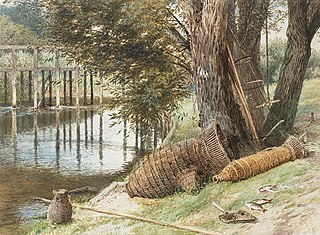Related Research Articles

Magna Carta Libertatum, commonly called Magna Carta or sometimes Magna Charta, is a royal charter of rights agreed to by King John of England at Runnymede, near Windsor, on 15 June 1215. First drafted by the Archbishop of Canterbury, Cardinal Stephen Langton, to make peace between the unpopular king and a group of rebel barons, it promised the protection of church rights, protection for the barons from illegal imprisonment, access to swift and impartial justice, and limitations on feudal payments to the Crown, to be implemented through a council of 25 barons. Neither side stood by their commitments, and the charter was annulled by Pope Innocent III, leading to the First Barons' War.

Hubert Walter was an influential royal adviser in the late twelfth and early thirteenth centuries in the positions of Chief Justiciar of England, Archbishop of Canterbury, and Lord Chancellor. As chancellor, Walter began the keeping of the Charter Roll, a record of all charters issued by the chancery. Walter was not noted for his holiness in life or learning, but historians have judged him one of the most outstanding government ministers in English history.

The Earldom of Chester was one of the most powerful earldoms in medieval England, extending principally over the counties of Cheshire and Flintshire. Since 1301 the title has generally been granted to heirs apparent to the English throne, and after 1707 the British throne. From the late 14th century, it has been given only in conjunction with that of Prince of Wales.
A hundred is an administrative division that is geographically part of a larger region. It was formerly used in England, Wales, some parts of the United States, Denmark, Southern Schleswig, Sweden, Finland, Norway, the Bishopric of Ösel–Wiek, Curonia, the Ukrainian state of the Cossack Hetmanate and in Cumberland County in the British Colony of New South Wales. It is still used in other places, including in Australia.

William de Longchamp was a medieval Lord Chancellor, Chief Justiciar, and Bishop of Ely in England. Born to a humble family in Normandy, he owed his advancement to royal favour. Although contemporary writers accused Longchamp's father of being the son of a peasant, he held land as a knight. Longchamp first served Henry II's illegitimate son Geoffrey, but quickly transferred to the service of Richard I, Henry's heir. When Richard became king in 1189, Longchamp paid £3,000 for the office of Chancellor, and was soon named to the see, or bishopric, of Ely and appointed legate by the pope.
Frankpledge was a system of joint suretyship common in England throughout the Early Middle Ages and High Middle Ages. The essential characteristic was the compulsory sharing of responsibility among persons connected in tithings. This unit, under a leader known as the chief-pledge or tithing-man, was then responsible for producing any man of that tithing suspected of a crime. If the man did not appear, the entire group could be fined.

Anglo-Saxon law is a body of written rules and customs that were in place during the Anglo-Saxon period in England, before the Norman conquest. This body of law, along with early Medieval Scandinavian law and Germanic law, descended from a family of ancient Germanic custom and legal thought. However, Anglo-Saxon law codes are distinct from other early Germanic legal statements—known as the leges barbarorum, in part because they were written in Old English instead of in Latin. The laws of the Anglo-Saxons were the second in medieval Western Europe after those of the Irish to be expressed in a language other than Latin.
The court leet was a historical court baron of England and Wales and Ireland that exercised the "view of frankpledge" and its attendant police jurisdiction, which was normally restricted to the hundred courts.

The Statute of Marlborough is a set of laws passed by the Parliament of England during the reign of Henry III in 1267. The laws comprised 29 chapters, of which four are still in force. Those four chapters constitute the oldest piece of statute law in the United Kingdom still in force as of 2024.
Vill is a term used in English, Welsh and Irish history to describe a basic rural land unit, roughly comparable to that of a parish, manor, village or tithing.

The manorial courts were the lowest courts of law in England during the feudal period. They had a civil jurisdiction limited both in subject matter and geography. They dealt with matters over which the lord of the manor had jurisdiction, primarily torts, local contracts and land tenure, and their powers only extended to those who lived within the lands of the manor: the demesne and such lands as the lord had enfeoffed to others, and to those who held land therein. Historians have divided manorial courts into those that were primarily seignorial – based on feudal responsibilities – and those based on separate delegation of authority from the monarch. There were three types of manorial court: the court of the honour; the court baron; and the court customary, also known as the halmote court.

An eel buck or eel basket is a type of fish trap that was prevalent in the River Thames in England up to the 20th century. It was used particularly to catch eels, which were a staple part of the London diet.
The Close Rolls are an administrative record created in medieval England, Wales, Ireland and the Channel Islands by the royal chancery, in order to preserve a central record of all letters close issued by the chancery in the name of the Crown.
Whorwellsdown was a hundred of the English county of Wiltshire, lying in the west of the county to the south of the towns of Bradford on Avon and Melksham and to the north and east of Westbury. An arm of the hundred reached several miles southwards into Salisbury Plain, with a detached portion, a tithing of Tilshead, lying high on the Plain about five miles east of the southern arm of the rest of the hundred. At its western end, it reached as far as the Somerset county boundary.
The Hundred of Horethorne is one of the 40 historical Hundreds in the historic county of Somerset, England, dating from before the Norman conquest during the Anglo-Saxon era although exact dates are unknown. Each hundred had a 'fyrd', which acted as the local defence force and a court which was responsible for the maintenance of the frankpledge system. They also formed a unit for the collection of taxes. The role of the hundred court was described in the Dooms (laws) of King Edgar. The name of the hundred was normally that of its meeting-place.
Beatrix de Vesci of Alnwick Castle, was an eleventh-century medieval noble lady of house de Vesci.
The Inquest of Sheriffs was a commission held by King Henry II of England in 1170 into the conditions of local government in England.

Government in Anglo-Saxon England covers English government during the Anglo-Saxon period from the 5th century until the Norman Conquest in 1066. See Government in medieval England for developments after 1066.

From the Norman Conquest of 1066 to the death of King John in 1216, England was governed by the Norman and Angevin dynasties. The Norman kings preserved and built upon the institutions of Anglo-Saxon government. They also introduced new institutions, in particular, feudalism. For later developments in English government, see Government in late medieval England.
References
- ↑ W. A. Morris, The Medieval Sheriff (New York 1968), p. 119-22
- ↑ W. A. Morris, The Medieval Sheriff (New York 1968), p. 119-22
- ↑ G. O. Sayles, The Medieval Foundations of England (London 1967), p. 184
- ↑ A. Muson, Medieval Law in Context (2001), p. 95
- ↑ W. A. Morris, The Medieval Sheriff (New York 1968), p. 182 and 246
- ↑ W. A. Morris, The Medieval Sheriff (New York 1968), p. 156
- ↑ J. Burton, Authority and Resistance in the Age of Magna Carta (2015), p. 38
- ↑ W. A. Morris, The Medieval Sheriff (New York 1968), p. 156
- ↑ W. A. Morris, The Medieval Sheriff (New York 1968), p. 175
- ↑ W. A. Morris, The Medieval Sheriff (New York 1968), p. 203
- ↑ T. G. Watkin, The Legal History of Wales (2012)
- ↑ J. Reeves, History of the English Law (1880), p. 14